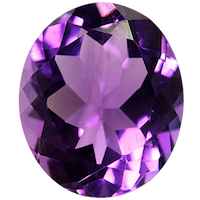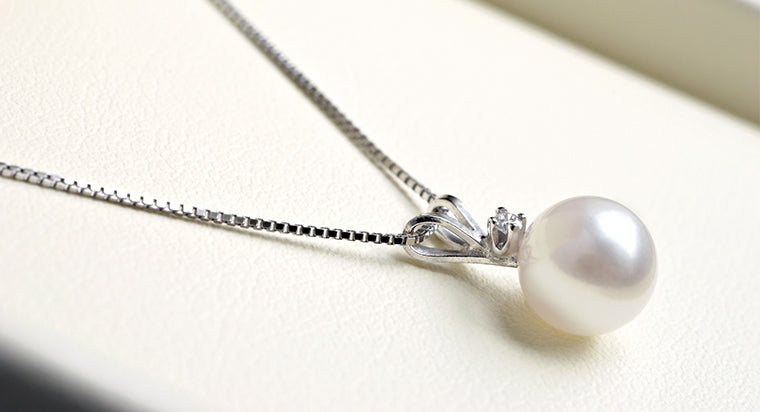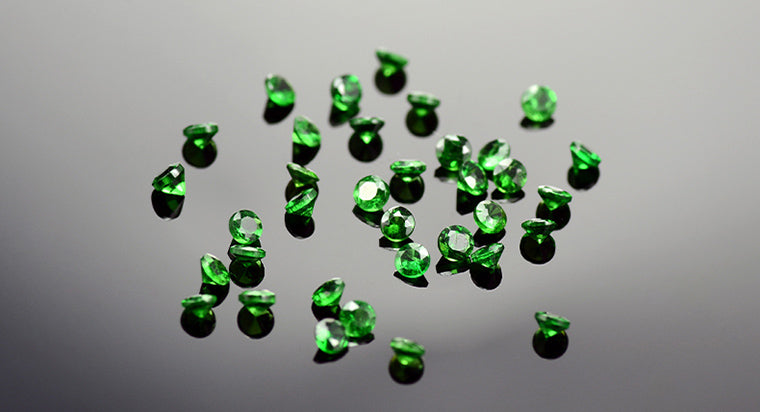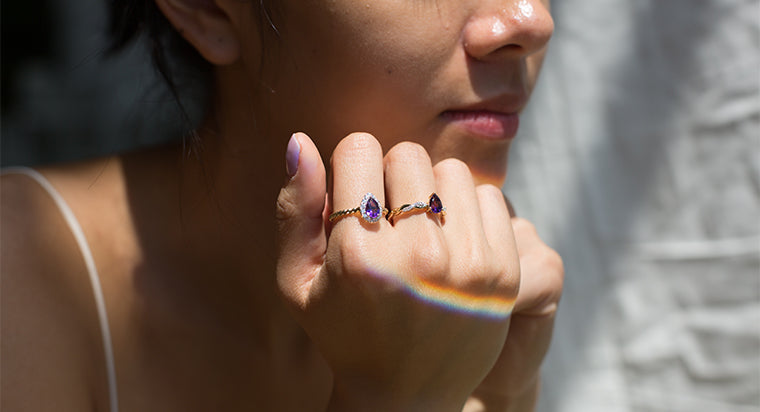Natural vs Lab or Synthetic Amethyst
No matter what type of gemstones you hope to buy, there’s always the question of lab-created stones or natural, mined ones. At With Clarity, we feel that the customer should understand the differences before purchasing amethyst jewelry. Here are the distinctions.
TABLE OF CONTENTS
Natural Amethyst:
Value
Amethyst is, by definition,  crystalline silicon dioxide). The purple color ranges from fairly light, called “Rose de France."

To a deep violet purple, the best of which has some flashes of blue and red (Siberian Amethyst).
Most Expensive Amethyst
In terms of value, the Siberian amethyst variety is the most expensive, and traditionally this is what has been used in fine jewelry. Furthermore, the most faceted amethyst is eye clean, meaning you won’t see any flaws without magnification. In fine jewelry, amethyst is priced almost exclusively based on size and color saturation.

With Clarity Amethyst
Amethyst is an affordable gemstone. At With Clarity, you can buy a half-carat round amethyst set in 14K white gold for around $3.50. The same ring with a two carat gem is only $530, giving you an idea of how economical a natural amethyst engagement ring can be.
On the high end, a two-carat center amethyst with diamond halo ring in 14K white gold will set you back just over $2,100. This ring makes a statement.
Want something trendy? All our amethyst rings are available in 14K rose gold. Special order rings can be set with amethysts up to 3.05 carats and cost up to $3,000. The great news is there are many carat ranges, metals and shapes to choose from, ensuring that you can get something fabulous within your budget.
Natural Amethyst Properties
As explained above, amethyst is an affordable gemstone. But this wasn’t always the case: amethyst jewelry was exclusive to the wealthy and powerful for centuries and has been made into jewelry since antiquity.
Amethyst Mining Deposits
Although amethyst is a relatively common gemstone now, its main deposits are in South America (Uruguay, Brazil), Canada, Africa (Morocco, Madagascar, Zambia), India, China, and Russia.
Years ago there were some amethyst deposits in the Alps, but these are largely exhausted. However, centuries ago, the mines in the Americas and Africa would have been unknown. Therefore, leaving those in Europe and Asia. This meant that amethyst was considered much rarer, and was much more expensive, years ago.
On the Mohs Scale: Hardness Grade
Amethyst is a relatively durable gemstone, with a Mohs hardness of 7. This means that it is fairly durable in jewelry for regular wear. However, this is softer than many gemstones made into fine jewelry, so you should be careful to protect it from scratching in your jewelry box. If you wear a natural amethyst engagement ring, you should expect it to need polishing after a few years due to regular wear.
Color
Many of you might be wondering, how does a natural amethyst gemstone get its color? Over the years, gemologists and chemists have found that  there are two aspects of amethyst color.
- Iron must be present in the quartz crystal.
- There must be the right conditions to irradiate the iron and produce purple color. Ideally, the amount of iron and radiation will be uniform throughout the natural amethyst rock. This allows the faceted amethyst or natural amethyst cabochon to be fashioned so that there is little color zoning.
- Although most amethyst used in jewelry is untreated, the darkest and lightest natural amethyst crystal can be heat treated to improve its shade. There are two ways this is done.
- When subjected to lower temperatures (400-600C), the color can be lightened from amethyst that looks almost black into the Siberian shade. It can also be done to darken Rose de France amethyst into a Siberian color.
- Alternatively, amethyst can be turned at even higher temperatures into yellow citrine or green prasiolite. Pressure is usually applied to prevent the crystal from cracking, and these color changes are permanent.
Fine-quality treated stones become natural AAA amethyst, while untreated stones can be called AAAA. At With Clarity, we use treated AAA stones in our jewelry.
Lab Created Amethyst
Lab-created amethysts are generally not commercially important, but we want our customers to know about them. These lab grown amethysts are chemically and optically the same as natural amethysts, with two main differences:
1. They tend to be naturally more uniform in color, and they don’t have the flaws of natural amethyst crystals. That’s because they are grown using an accelerated version of the natural growing process, but there aren’t the opportunities for foreign crystals to grow or other material to be introduced from the surrounding environment.
Want to know the difference between natural and lab made amethysts? Experienced gemologists can tell the difference due to variations in crystal growth structure. However, your best option is to purchase your amethyst jewelry from a reputable jeweler. Ethically, jewelers are required to tell you if the jewelry is made from lab amethyst or natural amethyst, and what grade the stone belongs to.
2. Another difference is that if a stone is heat-treated, that means it’s natural. Remember, treatments are used to correct flaws in natural stones, and there’s no point in doing this with synthetics. Treatments are a permanent and completely safe way to improve the look of gemstones. Gemstones used to craft jewelry are treated in the majority of cases.
Amethyst Buying tips
Want to buy an amethyst ring for yourself or someone you love? Before you run out and start shopping, consider the following:
Budget:
Amethyst is cheap, but it’s still important to know how much you can spend. We love the fact that even statement rings are often affordable. However, unless you have a budget in mind it’s easy to get overwhelmed with choices.
Gemstone Shape:
No matter your budget, have an idea of her preferences or know what you want before shopping. Some shapes are more becoming to longer or shorter fingers, for instance.
Size and Color:
The larger and darker of a stone you select, the more expensive it’ll be. However, you want to make sure that your choice is something she’ll enjoy. Don’t be afraid to buy a Rose de France ring if she’s crazy about pastel purple, for instance. And if she doesn’t like statement jewelry, you might be better off choosing a smaller stone even if you can afford a large one.
Getting Started
Work with our gemologists to find the perfect piece of amethyst jewelry for her. They are always available to sort through options and even help craft something completely different or custom.
FAQs
Which amethyst is the most expensive?
The Siberian amethyst is the most expensive variety of amethyst. It is deep purple with red and blue flashes and is most often used in fine jewelry. Amethyst is priced almost exclusively based on size and color saturation.
Where is amethyst found?
Amethyst is found in South America (Uruguay, Brazil), Canada, Africa (Morocco, Madagascar, Zambia), India, China, and Russia.
Is amethyst a durable gemstone?
Amethyst is a considerably durable gemstone with a rating of 7 on Mohs scale. However, like all gemstones, it must be treated with love and care.
How does amethyst get its color?
Amethyst is a purple variety of quartz and gets its purple color due to the presence of iron. Many times, the stone is also subjected to irradiation and heat treatments to improve its color.
What is the difference between lab-created amethyst and natural amethyst?
While a lab-created amethyst is chemically and optically the same as a natural amethyst, there are two main differences between them. A lab-grown amethyst will have a more uniform color because they are grown in a controlled environment and will not be heat-treated. Natural amethysts, on the other hand, are heat treated. They usually do not have a uniform color and will show the presence of natural flaws.









